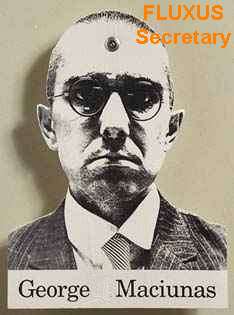| FLUXUS - THE ART MOVEMENT | |
|
Fluxus Indians invented and developed a system for creating and studying ARTIFICIAL CULTURES
that involved rearranging and redefining existing symbols, rituals, and games (see
The Mix-Up Game). The basic method was to take things out of their normal context (e.g., words, images,
fashions, sounds, rules, behaviors) and arrange them in new ways. This experimental activity--called
THE FLUXUS CONCEPT--was not only a major source of fun for the Fluxus Indians, it provided them with
a profound understanding of how cultures operate.
As an adolescent, Thomas Edison discovered the Fluxus Indians ideas about Artificial Cultures and The Fluxus Concept (see Thomas Edison and The Fluxus Indians). Although he was primarily interested in their ideas for inventions, Edison claimed that he had made--and then lost--extensive notes about Artificial Cultures and The Fluxus Concept. |
George Maciunas, a Lithuanian immigrant, discovered and purchased unpublished loose-leaf notes
describing Artificial Cultures and The Fluxus Concept in a bookstore in New York in
1960. The authorship was anonymous, but all signs now point to Thomas Edison.
In these notes, George Maciunas found the inspiration he had been seeking for a new approach to redefining and recreating art. Maciunas and his young colleagues adopted the Fluxus name and concepts (circa 1962) and applied them throughout an international art scene (see Exhibition Notes). |
 |
|
This obscure Fluxus art movement has been called "the most radical art movement
of the the nineteen sixties," and was certainly a major contributor to the spirit of that time. Today, Fluxus is alive and well on the internet.
To learn more about Fluxus visit Fluxlist. |
 |
© 2006 Allen Bukoff & FLUXUS Midwest



